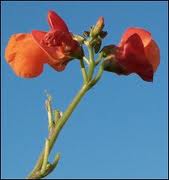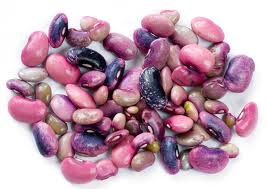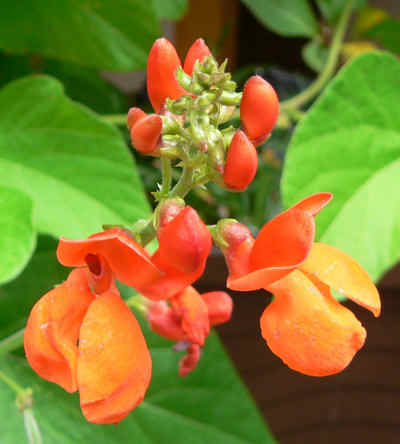
Two beans are grown for beauty, the Hyacinth Bean, edible with precautions, and the Scarlet Runner Bean, also edible.
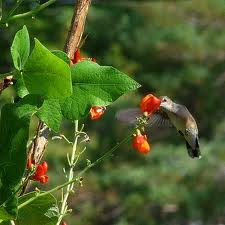
It’s interesting that these two beans are so unlike the rest of the bean world yet so much alike. Both trail, that is, love to climb. They are showy, one towards purple the other red. They are perennials though are treated as annuals, and have starchy, edible roots. Their young leaves are eaten as well as their beans. Like the Hyacinth Bean the Scarlet Runner Bean also has tasty edible flowers. For the Hyacinth Bean go here.
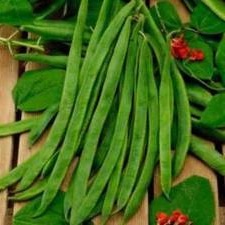
Botanically in Dead Latin the Scarlet Runner Bean is Phaseolus coccineus (fay-see-OH-lus koh-SIN-ee-us.) That’s the bastardization of two living Greek words that mean “Red Bean” though the seeds are multi-colored. (In Greek it’s: fah-SO-lee KOH-kee-no.) The Scarlet Runner Bean has also been called the Oregon Lima Bean, Aycoctl by the Aztecs, and Ayocote by the Spanish. It’s native to Central America and has escaped cultivation in many areas. This bean is still on the home kitchen menu in its original range but the rest of the world grows it as an ornamental. Lots of folks also use it as a nectar attraction for hummingbirds and butterflies. Historically, Scarlet Runner Bean was in English and early American gardens by the 1600s.
There are some dozen and a half cultivars now. (Cultivars are made by man, varieties are made by nature.) The Dutch Phaseolus coccineus v. alba has white flowers. The “Butler” is stringless, “Painted Lady” has red and white flowers, the “Kelvedon Wonder” is an early variety with long pods, “Sunset” has pink flowers, and the “Scarlet Emperor” …has scarlet flowers. Under right conditions the Scarlet Runner Bean is the most productive of all the planted beans.
Like most beans the Scarlet Runner Bean contains small amounts of the lectin phytohaemagglutinin (figh-toe-hee-mah-GLUE-tin-inn.) The highest amount is in uncooked red kidney beans. It’s toxic in large amounts which is why kidney beans are always long-cooked. As few as five raw kidney beans can cause symptoms such as losing fluids and feeling lousy for four or five hours. While there are many people who report they eat Scarlet Runner Beans seeds raw it is a good practice to cook them. The young pods before beans truly develop are eaten raw.
I have planted both to climb guy wires near local telephone poles. It’s a win win win as they say. The ugly wire is covered with an attractive vine and blossom, I get to harvest the bean without having to give up any space or create a trellis, and the birds and bees are happy.
Green Deane’s “Itemized” Plant Profile: Scarlet Runner Bean
IDENTIFICATION: Phaseolus coccineus: Quick-growing vines, typical bean three-leaflet, dark green with purple tinged veins underneath, to 15 feet long/tall, red flowers borne in clusters like sweet peas, slender pods to a foot long. Seeds lima bean shape, color varies from shining black to violet-black mottled with deep red.
TIME OF YEAR: All year in warm climates, seasonally in temperate summer and fall
ENVIRONMENT: Fertile soil, adequate moisture, full sun, preferably something to climb on or it will ball up on the ground. Does better in moderate climates than either very hot or very cold.
METHOD OF PREPARATION: Young tender pods sparingly raw. Usually they are boiled, steamed, sauteed, baked, French-cut (in strips) before cooking; immature seeds used like shelled beans, read cooked; ripe, dried seeds used like dry kidney or Lima beans, long cooked; flowers have a bean-like flavor and are used in salads. Young leaves used as a pot herb, starchy root cooked. It is good food for cattle as well.

